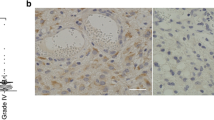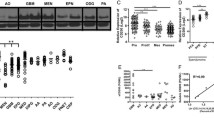Abstract
Despite the immunogenicity of glioblastoma multiforme (GBM), immune-mediated eradication of these tumors remains deficient. Regulatory T cells (Tregs) in the blood and within the tumor microenvironment of GBM patients are known to contribute to their dismal immune responses. Here, we determined which chemokine secreted by gliomas can preferentially induce Treg recruitment and migration. In the malignant human glioma cell lines D-54, U-87, U-251, and LN-229, the chemokines CCL22 and CCL2 were detected by intracellular cytokine analysis. Furthermore, tumor cells from eight patients with GBM had a similar chemokine expression profile. However, only CCL2 was detected by enzyme-linked immunosorbent assay, indicating that CCL2 may be the principal chemokine for Treg migration in GBM patients. Interestingly, the Tregs from GBM patients had significantly higher expression levels of the CCL2 receptor CCR4 than did Tregs from healthy controls. Glioma supernatants and the recombinant human chemokines CCL2 and CCL22 induced Treg migration and were blocked by antibodies to the chemokine receptors. Production of CCL2 by glioma cells could also be mitigated by the chemotherapeutic agents temozolomide and carmustine [3-bis (2-chloroethyl)-1-nitrosourea]. Our results indicate that gliomas augment immunosuppression by selective chemokine-mediated recruitment of Tregs into the tumor microenvironment and that modulating this interaction with chemotherapy could facilitate the development of novel immunotherapeutics to malignant gliomas.





Similar content being viewed by others
Abbreviations
- APC:
-
Antigen presenting cell
- BCNU:
-
Carmustine [3-bis (2-chloroethyl)-1-nitrosourea]
- ELISA:
-
Enzyme-linked immunosorbent assay
- FACS:
-
Fluorescence-activated cell sorter
- FITC:
-
Fluorescein isothiocyanate
- GBM:
-
Glioblastoma multiforme
- IL:
-
Interleukin
- MEM:
-
Minimum essential medium
- PBMC:
-
Peripheral blood mononuclear cell
- PBS:
-
Phosphate-buffered saline
- Treg:
-
Regulatory T cell
References
Allavena P, Signorelli M, Chieppa M, Erba E, Bianchi G, Marchesi F, Olimpio CO, Bonardi C, Garbi A, Lissoni A, de Braud F, Jimeno J, D’Incalci M (2005) Anti-inflammatory properties of the novel antitumor agent yondelis (trabectedin): inhibition of macrophage differentiation and cytokine production. Cancer Res 65:2964–2971
Aloisi F (2001) Immune function of microglia. Glia 36:165–179
Calzascia T, Di Berardino-Besson W, Wilmotte R, Masson F, de Tribolet N, Dietrich PY, Walker PR (2003) Cutting edge: cross-presentation as a mechanism for efficient recruitment of tumor-specific CTL to the brain. J Immunol 171:2187–2191
Calzascia T, Masson F, Di Berardino-Besson W, Contassot E, Wilmotte R, Aurrand-Lions M, Ruegg C, Dietrich PY, Walker PR (2005) Homing phenotypes of tumor-specific CD8 T cells are predetermined at the tumor site by crosspresenting APCs. Immunity 22:175–184
Curiel TJ, Coukos G, Zou L, Alvarez X, Cheng P, Mottram P, Evdemon-Hogan M, Conejo-Garcia JR, Zhang L, Burow M, Zhu Y, Wei S, Kryczek I, Daniel B, Gordon A, Myers L, Lackner A, Disis ML, Knutson KL, Chen L, Zou W (2004) Specific recruitment of regulatory T cells in ovarian carcinoma fosters immune privilege and predicts reduced survival. Nat Med 10:942–949
Desbaillets I, Tada M, de Tribolet N, Diserens AC, Hamou MF, Van Meir EG (1994) Human astrocytomas and glioblastomas express monocyte chemoattractant protein-1 (MCP-1) in vivo and in vitro. Int J Cancer 58:240–247
Fecci PE, Mitchell DA, Whitesides JF, Xie W, Friedman AH, Archer GE, Herndon JE 2nd, Bigner DD, Dranoff G, Sampson JH (2006) Increased regulatory T-cell fraction amidst a diminished CD4 compartment explains cellular immune defects in patients with malignant glioma. Cancer Res 66:3294–3302
Fleming AB, Saltzman WM (2002) Pharmacokinetics of the carmustine implant. Clin Pharmacokinet 41:403–419
Hassenbusch SJ, Anderson JH, Colvin OM (1996) Predicted and actual BCNU concentrations in normal rabbit brain during intraarterial and intravenous infusions. J Neurooncol 30:7–18
Hu S, Chao CC, Ehrlich LC, Sheng WS, Sutton RL, Rockswold GL, Peterson PK (1999) Inhibition of microglial cell RANTES production by IL-10 and TGF-beta. J Leukoc Biol 65:815–821
Hussain SF, Yang D, Suki D, Aldape K, Grimm E, Heimberger AB (2006) The role of human glioma-infiltrating microglia/macrophages in mediating anti-tumor immune responses. Neuro-oncol 8:261–279
Kimura T, Takeshima H, Nomiyama N, Nishi T, Kino T, Kochi M, Kuratsu JI, Ushio Y (2002) Expression of lymphocyte-specific chemokines in human malignant glioma: essential role of LARC in cellular immunity of malignant glioma. Int J Oncol 21:707–715
Kuratsu J, Yoshizato K, Yoshimura T, Leonard EJ, Takeshima H, Ushio Y (1993) Quantitative study of monocyte chemoattractant protein-1 (MCP-1) in cerebrospinal fluid and cyst fluid from patients with malignant glioma. J Natl Cancer Inst 85:1836–1839
Kurpad SN, Zhao XG, Wikstrand CJ, Batra SK, McLendon RE, Bigner DD (1995) Tumor antigens in astrocytic gliomas [Review]. GLIA 15:244–256
Laouar A, Wietzerbin J, Bauvois B (1993) Divergent regulation of cell surface protease expression in HL-60 cells differentiated into macrophages with granulocyte macrophage colony stimulating factor or neutrophils with retinoic acid. Int Immunol 5:965–973
Mahad DJ, Ransohoff RM (2003) The role of MCP-1 (CCL2) and CCR2 in multiple sclerosis and experimental autoimmune encephalomyelitis (EAE). Semin Immunol 15:23–32
Miller AM, Lundberg K, Ozenci V, Banham AH, Hellstrom M, Egevad L, Pisa P (2006) CD4+CD25high T cells are enriched in the tumor and peripheral blood of prostate cancer patients. J Immunol 177:7398–7405
Motl S, Zhuang Y, Waters CM, Stewart CF (2006) Pharmacokinetic considerations in the treatment of CNS Tumours. Clin Pharmacokinet 45:871–903
Newlands ES, Stevens MF, Wedge SR, Wheelhouse RT, Brock C (1997) Temozolomide: a review of its discovery, chemical properties, pre-clinical development and clinical trials. Cancer Treat Rev 23:35–61
Proost P, Struyf S, Schols D, Opdenakker G, Sozzani S, Allavena P, Mantovani A, Augustyns K, Bal G, Haemers A, Lambeir AM, Scharpe S, Van Damme J, De Meester I (1999) Truncation of macrophage-derived chemokine by CD26/dipeptidyl-peptidase IV beyond its predicted cleavage site affects chemotactic activity and CC chemokine receptor 4 interaction. J Biol Chem 274:3988–3993
Rhines LD, Sampath P, DiMeco F, Lawson HC, Tyler BM, Hanes J, Olivi A, Brem H (2003) Local immunotherapy with interleukin-2 delivered from biodegradable polymer microspheres combined with interstitial chemotherapy: a novel treatment for experimental malignant glioma. Neurosurgery 52:872–879, discussion 879–880
Rosenberg SA, Yang JC, Restifo NP (2004) Cancer immunotherapy: moving beyond current vaccines. Nat Med 10:909–915
Roussel E, Gingras MC, Grimm EA, Bruner JM, Moser RP (1996) Predominance of a type 2 intratumoural immune response in fresh tumour-infiltrating lymphocytes from human gliomas. Clin Exp Immunol 105:344–352
Sebastiani S, Allavena P, Albanesi C, Nasorri F, Bianchi G, Traidl C, Sozzani S, Girolomoni G, Cavani A (2001) Chemokine receptor expression and function in CD4+ T lymphocytes with regulatory activity. J Immunol 166:996–1002
Sedo A, Malik R, Vicar J, Simanek V, Ulrichova J (2003) Quaternary benzo[c]phenanthridine alkaloids as inhibitors of dipeptidyl peptidase IV-like activity baring enzymes in human blood plasma and glioma cell lines. Physiol Res 52:367–372
Struyf S, Proost P, Sozzani S, Mantovani A, Wuyts A, Declercq E, Schols D, Van Damme J (1998) Enhanced anti-HIV-1 activity and altered chemotactic potency of NH2-terminally processed macrophage-derived chemoking (MDC) imply an addtional MDC receptor. J Immunol 161:2672–2675
Su YB, Sohn S, Krown SE, Livingston PO, Wolchok JD, Quinn C, Williams L, Foster T, Sepkowitz KA, Chapman PB (2004) Selective CD4+ lymphopenia in melanoma patients treated with temozolomide: a toxicity with therapeutic implications. J Clin Oncol 22:610–616
Szanya V, Ermann J, Taylor C, Holness C, Fathman CG (2002) The subpopulation of CD4+CD25+ splenocytes that delays adoptive transfer of diabetes expresses L-selectin and high levels of CCR7. J Immunol 169:2461–2465
Tran PB, Miller RJ (2003) Chemokine receptors: signposts to brain development and disease. Nat Rev Neurosci 4:444–455
Vincent VA, Tilders FJ, Van Dam AM (1997) Inhibition of endotoxin-induced nitric oxide synthase production in microglial cells by the presence of astroglial cells: a role for transforming growth factor beta. Glia 19:190–198
Zhang T, Somasundaram R, Berencsi K, Caputo L, Gimotty P, Rani P, Guerry D, Swoboda R, Herlyn D (2006) Migration of cytotoxic T lymphocytes toward melanoma cells in three-dimensional organotypic culture is dependent on CCL2 and CCR4. Eur J Immunol 36:457–467
Acknowledgments
We are grateful to Lamonne Crutcher for assistance in obtaining patient specimens. This work was supported by recruitment start-up funds for the Department of Neurosurgery, The University of Texas M. D. Anderson Cancer Center; by the National Brain Tumor Foundation Translational Grant; by The Rose Foundation; and by National Institutes of Health grant RO1 CA120813-01A1.
Author information
Authors and Affiliations
Corresponding author
Additional information
Justin T. Jordan and Wei Sun are contributed equally to this work.
An erratum to this article can be found at http://dx.doi.org/10.1007/s00262-007-0403-3
Rights and permissions
About this article
Cite this article
Jordan, J.T., Sun, W., Hussain, S.F. et al. Preferential migration of regulatory T cells mediated by glioma-secreted chemokines can be blocked with chemotherapy. Cancer Immunol Immunother 57, 123–131 (2008). https://doi.org/10.1007/s00262-007-0336-x
Received:
Accepted:
Published:
Issue Date:
DOI: https://doi.org/10.1007/s00262-007-0336-x




